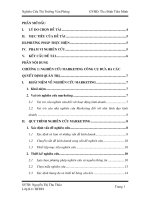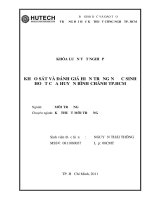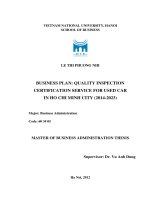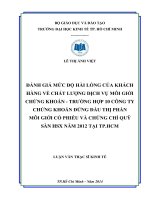Đánh giá việc thực thi quy hoạch chung xây dựng tại thành phố hồ chí minh – lý thuyết và thực tiễn tt tiếng anh
Bạn đang xem bản rút gọn của tài liệu. Xem và tải ngay bản đầy đủ của tài liệu tại đây (1.22 MB, 32 trang )
MINISTRY OF
EDUCATION AND TRAINING
MINISTRY OF
CONSTRUCTION
UNIVERSITY OF ARCHITECTURE HO CHI MINH CITY
________________________
Pham Tran Hai
THE IMPLEMENTATION EVALUATION OF
THE MASTER PLANS IN HO CHI MINH CITY
– THEORIES AND PRACTICES
Field of study
Code
: REGIONAL AND URBAN PLANNING
: 9.58.01.05
THE DISSERTATION SUMMARY
IN REGIONAL AND URBAN PLANNING
HCMC – 2020
This dissertation is accomplished at:
THE UNIVERSITY OF ARCHITECTURE HCMC
The academic supervisor:
ASSOCIATE PROF., DR., ARCH. TRAN BUT
The reviewer 1: PROF., DR., ARCH. DO HAU
The reviewer 2: PROF., DR., ARCH. NGUYEN QUOC THONG
The reviewer 3: ASSOCIATE PROF., DR., ARCH. LE ANH DUC
This dissertation was defensed at University Dissertation Assessement
Committee organized at The University of Architecture HCMC.
At ... o’clock, dated ...
This dissertation could be found at:
GENERAL LIBRARY OF HCMC
LIBRARY OF THE UNIVERSITY OF ARCHITECTURE HCMC
TABLE OF CONTENTS
TABLE OF CONTENTS ................................................................. 1
Part I. INTRODUCTION ................................................................ 1
1. Rationale .................................................................................. 1
2. The subjects and the scope of the study................................. 2
3. The objectives of the study ..................................................... 2
4. The study methods................................................................... 2
5. The meanings of the study ...................................................... 3
Part II. STUDY CONTENTS .......................................................... 3
Chapter 1. Overview of the implementation evaluation of the
HCMC Master Plan .................................................................... 3
1.1. The plan implementation evaluation .................................... 3
1.2. The plan system in Viet Nam ................................................ 4
1.3. The HCMC Master Plan in the provincial plan system of
HCMC ........................................................................................... 5
1.4. The implementation evaluation of the HCMC Master Plan
and the issues raised ..................................................................... 6
Chapter 2. Scientific basis for the implementation evaluation
of the HCMC Master Plan .......................................................... 8
2.1. Theoretical basis for the plan implementation evaluation ... 8
2.2. International practices for the plan implementation
evaluation.................................................................................... 10
2.3. Legal basis for the plan implementation evaluation in Viet
Nam ............................................................................................. 12
Chapter 3. Proposing and applying the set of indicators for the
implementation evaluation of the HCMC Master Plan ......... 13
3.1. The system of viewpoints for the implementation evaluation
of the HCMC Master Plan ......................................................... 13
3.2. Proposing the set of indicators for the implementation
evaluation of the HCMC Master Plan ....................................... 14
3.3. Implementation evaluation of “The Revised HCMC Master
Plan to 2025” in the period 2010-2015 ...................................... 16
3.4. Result analysis of the implementation evaluation of “The
Revised HCMC Master Plan to 2025” in the period 20102015 ............................................................................................. 19
Chapter 4. Discussion ................................................................ 19
4.1. Discussion about the system of viewpoints for the
implementation evaluation of the HCMC Master Plan ............ 19
4.2. Discussion about the set of indicators for the implementation
evaluation of the HCMC Master Plan ....................................... 19
4.3. Discussion about the result of the implementation evaluation
of “The Revised HCMC Master Plan to 2025” in the period 20102015 ............................................................................................. 20
Part III. CONCLUSIONS AND RECOMMENDATIONS ........ 20
1. Conclusions ............................................................................ 20
2. Recommendations ................................................................. 22
LIST OF THE PUBLICATIONS OF THE AUTHOR RELATED
TO THE DISSERTATION ................................................................
1
Part I. INTRODUCTION
1. Rationale
Planning is a complicated forecast science because it depends on many
factors; therefore, it is not possible to ensure the accuracy of what are
implemented in comparision with what are planned. Results of plan
mplementation evaluation are the basis for: (i) revising or
promulgating new policies to promote the implementation of the plan;
(ii) revising or formulate new plan. Since 1993, three versions of the
HCMC Master Plan were formulated, appraised and approved as
follows: “The HCMC Master Plan to 2010”, “The Revised HCMC
Master Plan to 2020”, “The Revised HCMC Master Plan to 2025”.
The implementation evaluation of the HCMC Master Plan has not
been relied on comprehensive studies in recent years, so there are
many shortcomings as follows: (i) this evaluation has not yet been
integrated into the implementation evaluation of of the provincial plan
system of HCMC; (ii) this evaluation is insufficient regarding
conformance-based and performance-based evaluation factors; (iii)
causality relationship between these factors has not been analyzed.
Recognizing
the
important
role
and
inadequacies
in
the
implementation evaluation of the HCMC Master Plan, a numbers of
relevant studies have been carried out, among which, the study
“Proposing A Framework for The Implementation Evaluation of
Master Plans and Socio-economic Development Plans of HCMC”
aimed to evaluate the implementation of the provincial plan system of
HCMC via a intergrated set of indicators.
On the basis of the above study, the dessertation is carried out: to
develop a system of viewpoints for implementation evaluation of the
HCMC Master Plan and on this basis, to propose a set of indicators for
2
implementation evaluation of the HCMC Master Plan; to evaluate the
implementation of “The Revised HCMC Master Plan to 2025” in the
period 2010-2015, using the proposed set of indicators; to discuss
about the study results and to propose suitable directions for revising
/ promulgating policies to promote the implementation of the HCMC
Master Plan and for revising / formulating the HCMC Master Plan.
2. The subjects and the scope of the study
The subjects of the study: the implementation evaluation of the HCMC
Master Plan in the context of provincial plan system of HCMC.
The scope of the study: (i) this dissertation focuses only on the HCMC
Master Plan, not all the master plans in HCMC; (ii) this dissertation is
limited in implementation evaluation of development indicators which
determined by quantitative objectives and quantified qualitative
targets of the HCMC Master Plan; (iii) this dissertation is limited in
HCMC administrative boundary in the context of HCMC region; (iv)
this dissertation results is verified in practice in the period 2010-2020.
3. The objectives of the study
- The objective 1: To develop a system of viewpoints for
implementation evaluation of the HCMC Master Plan.
- The objective 2: To propose a set of indicators for the
implementation evaluation of the HCMC Master Plan.
- The objective 3: To evaluate the implementation of “The Revised
HCMC Master Plan to 2025” in the period 2010-2015, using the
proposed set of indicators.
4. The study methods
The study methods (including: analytical – synthesis method,
systematic method, expert method and multi-criteria assessment
(MCA) method) are used in the following steps: (i) identifying the
3
issues raised from current situation of the implementation evaluation
of the HCMC Master Plan; (ii) developing the scientific basis to solve
the issues above; (iii) developing the system of viewpoints for the
implementation evaluation of the HCMC Master Plan; (iv) proposing
the set of indicators for the implementation evaluation of the HCMC
Master Plan; (v) carrying out the implementation evaluation of “The
Revised HCMC Master Plan to 2025” in the period 2010-2015; (v)
discussing
about
implementation
evaluation
results,
and
recommending and requesting.
5. The meanings of the study
Scientifically, the dessertation results contribute to the plan
implementation evaluation theory with: (i) the system of viewpoints
for the implementation evaluation of the HCMC Master Plan could be
widely applied to strategic plans; (ii) the set of indicators for the
implementation evaluation of the HCMC Master Plan could be widely
applied for this kind of plan in different period or other master plans
of other cities with different scales.
Practically, the dessertation results are the basic for revising / newly
promulgating policies to promote the implementation of the HCMC
Master Plan, and revising / newly formulating the HCMC Master Plan.
Part II. STUDY CONTENTS
Chapter 1. Overview of the implementation evaluation of the
HCMC Master Plan
1.1. The plan implementation evaluation
1.1.1. Relevant concepts regarding to the plan implementation
evaluation
- Plan (regulated at the Law of Planning no.21/2017/QH14).
4
- Spatial plan: regional plan; special function zone plan; urban plan
(master plan; zoning plan; detailed plan; technical infrastructure
plan for the cities under the central government); rural plan.
- Planning methods: comprehensive method and strategic method.
- Plan evaluation: ex-ante evaluation, on-going evaluation and expost evaluation.
- Plan implementation evaluation: on-going evaluation and ex-post
evaluation.
1.1.2. The role of the plan implementation evaluation
In the context of climate change and socio-economic and cultural
uncertainty, plan implementation evaluation has an important role for
revising / newly promulgating policies to promote the implementation
of the HCMC Master Plan, and revising / newly formulating the
HCMC Master Plan. In addition, the results of plan implementation
evaluation are also the basis for revising the planning methods.
1.2. The plan system in Viet Nam
1.2.1. The categorization of the plan system in Viet Nam
1.2.1.1. By effective subjects
Before the Law of Planning no. 21/2017 /QH14 in effective, the plan
system includes: (i) integrated socio-economic development plans; (ii)
sectoral plans; (iii) spatial plans; (iv) resource use plans (land use
plans, water resource plans, and mineral resource plans) and
environmental protection plans.
After the Law of Planning no. 21/2017 /QH14 in effective, the plan
system includes: (i) general plans at following levels: national,
regional, provincial, and special administrative – economic unit; (ii)
sea plan at the national level; (iii) land use plan at the national level;
(iv) other sectoral plans at the national level, including: group of
5
infrastructure plans, group of resources use plans, group of
environmental protection plans and group of biodiversity conservation
plans; (v) urban plans and rural plans; (vi) technical and sectoral plans
to detail the national, regional, and provincial plans, including spatial
plans.
1.2.1.2. By effective territories
The plan system includes following levels: national, regional (interprovincial); provincial; and local (inter-district and district).
1.2.2. The dissertation viewpoints on the categorization of the plan
system in Viet Nam
The plan system in Viet Nam is categorized as follows:
- Group of general plans, available at different levels: national,
regional, provincial, specialized administrative – economic unit.
- Group of sectoral plans: (i) subgroup of industry plans (at national
and regional levels); (ii) subgroup of spatial plans; (iii) subgroup
of resource use and environmental protection plans.
1.2.3. The dissertation viewpoints on the relationships in the plan
system in Viet Nam
The above groups of plan have an organic and close relationship in
three manners: "guidance and compliance", "update" and "support".
1.3. The HCMC Master Plan in the provincial plan system of HCMC
1.3.1. The description of the provincial plan system of HCMC
Provincial plan system of HCMC is described as categorized with
updated information about formulation, appraisal and approval.
1.3.2. The dissertation viewpoints on the role of the HCMC Master
Plan in the provincial plan system of HCMC
The role of the HCMC Master Plan in the provincial plan system of
HCMC are: (i) spatially directing the distribution of social resources
6
and activities in general according to the HCMC Socio – economic
General Plan; (ii) creating infrastructure and space for the
implementation of industry plans in HCMC, (iii) guiding the
protecting, exploiting and using natural resources mentioned at the
resource use plans in HCMC; guiding the environmental zoning and
environmental
infrastructure
distribution
mentioned
in
the
environmental protection plans in HCMC.
1.4. The implementation evaluation of the HCMC Master Plan and
the issues raised
1.4.1. Relevant studies on the plan implementation evaluation in Viet
Nam
The studies on plan implementation evaluation in Viet Nam are: the
papers about spatial plan implementation evaluation in the workshop
“Evaluating The Formulation and Implementation of Spatial Plans The Needs and The Methods” organized by Southern Institute of
Spatial Planning on 15th December 2017; the study “Basic Renovation
of Urban Planning in Viet Nam” done by the National Institute of
Urban and Rural Planning in 2019; the study “Analyzing and
Proposing urban development management model suitable with the
conditions of Viet Nam” done by Viet Nam Urban Development and
Planning Association in năm 2020; the books “New Residential Areas
in Hanoi - Two Decades Looking Back on A Model” (2016) and "New
Residential Areas: From Theoretical Origins to Practical Variations"
(2018) by Tran Minh Tung; the study “Proposing A Framework for
The Implementation Evaluation of Master Plans and Socio-economic
Development Plans of HCMC” conducted by the Institute of
Development Studies in HCMC in 2017.
7
1.4.2. Relevant studies on the implementation evaluation of the
HCMC Master Plan
1.4.2.1. Reports on the implementation evaluation of the HCMC
Master Plan
The implementation of “The HCMC Master Plan to 2010” had not
been evaluated due short implementation time (about 3 years). The
implementation of “The Revised HCMC Master Plan to 2020” was
evaluated with following reports: “The Implementation Evaluation of
The HCMC Master Plan to 2010 (period 1998-2005)” and “Study on
The Revising HCMC Master Plan to 2025”. The implementation of
“The Revised HCMC Master Plan to 2025” was evaluated with
following reports: “Reviewing and Evaluating the Implementation of
Decision no.24 dated 24th January 2010 of The Prime Minister” and
“The Formulation, Implementation and Management of Urban Plans
in HCMC”.
1.4.2.2. Other studies on the implementation evaluation of the HCMC
Master Plan
The other studies on the implementation evaluation of the HCMC
Master Plan are: the paper “Urban Development and Management
Implemented in Saigon South Urban Area and Phu My Hung New
City” at the workshop “Twenty Years of Building and Developing Phu
My Hung Urban Area” co-organized by the Phu My Hung
Development Company Limited and the HCMC Institute for
Development Studies in 17/05/2013; the article “The Role of HCMC
Municiple Government Model in Enhancing The Implementation of
Urban Development Orientation” published in the Journal of Urban
Planning (ISSN: 1859-3054), no.63 of the tenth year (2013), pages 4245; the paper “Re-Directing Urban Development in HCMC: Lessons
8
from Seoul, Korea” at the workshop “Architecture - Planning
Management of HCMC” co-organized by the HCMC People's
Committee and Ministry of Construction on 5-6/11/2015 in HCMC.
1.4.3. Issues raised from the implementation evaluation of the HCMC
Master Plan
The issues are raised as follows: (i) it is necessary to integrate the
implementation evaluation of the HCMC Master Plan into the
implementation evaluation of provincial plan system of HCMC; (ii)
there is a need to have a comprehensively implementation evaluation
of the HCMC Master Plan which includes conformance-based and
performance-based factors; (iii) it is necessary to analyze the causality
relationship between conformance-based and performance-based
factors of the implementation evaluation of the HCMC Master Plan,
hence to identify the problems raised from the current situation.
Chapter 2. Scientific basis for the implementation evaluation of
the HCMC Master Plan
2.1. Theoretical basis for the plan implementation evaluation
2.1.1. Current basic viewpoints of the plan implementation evaluation
Current basic viewpoints of the plan implementation evaluation:
planning is the control of the future, plan not to be implemented is a
failure (Wildavsky, 1973); the plan is considered effective and
successful when it is implemented and achieves more positive than
negative outputs (Alexander, 1981); the success of a plan depends on
the plan nature: project plan, strategic plan hybrid plan (Faludi, 1989).
2.1.2. Theories for the plan implementation evaluation
Theories for the plan implementation evaluation include: objectivedriven evaluation; theory-driven evaluation and theory-based
evaluation; utilisation-driven evaluation; or data-driven evaluation.
9
2.1.3. Methods for the plan implemention evaluation
2.1.3.1. Quantitative and non-quantitative evaluation
Quantitative evaluation is rarely used due to difficulties related to
methodology and data collection; however, its results are objective,
clear and specific. Non-quantitative evaluations which is also known
as qualitative evaluations is commonly used; however, its results are
subjective, not clear, and not specific.
2.1.3.2. Comformance-based and performance-based evaluation
The comformance-based evaluation is the comparison between what
are implemented and what are implemented; the comformance-based
evaluation is suitable with comprehensive and project plans. The
performance-based evaluation is based on how effective the plan is
and how the plan guides relevant decision-making processes; the
performance-based evaluation is suitable with strategic plans.
2.1.3.3. Effectiveness and efficiency evaluation
Effectiveness evaluation is the comparison between the outputs and
outcomes of the plan and the forecast contents of the plan. Efficiency
evaluation is the comparison between the costs of the plan
implementation with the benefits brought by plan implementation.
2.1.4. The set of indicators for the plan implementation evaluation
According to the study “Proposing A Framework for The
Implementation Evaluation of Master Plans and Socio-economic
Development Plans of HCMC ", the plan implemantation could be
evaluated with the set of quantitative indicators.
2.1.5. Factors affecting to the plan implementation evaluation
Factors affecting the plan implementation include: (i) factors related
to the plan nature: plan quality, plan system uniformity, and plan
revision; (ii) factors related to the plan context: political institutions,
10
socio-economic situation, real estate market trends,…; (iii) plan
implementation policies.
2.1.6. The dissertation viewpoints on the application of theoretical
basis into implementation evaluation of the HCMC Master Plan
The dissertation viewpoints include: (i) there is a need to integrate
conformance-based and performance-based evaluation in the
implementation evaluation of the HCMC Master Plan; (ii) the
implementation evaluation of the HCMC Master Plan could be
quantitative; (iii) the set of indicators for the implementation
evaluation of the HCMC Master Plan should have four groups
(“resources”, “activities”, “outputs” and “outcomes”).
2.2. International practices for the plan implementation evaluation
2.2.1. The plan system in other countries
Description of the plan systems in following countries: UK,
Netherlands, Korea, Indonesia, Malaysia, South Africa, New Zealand,
Russia, Japan, France, China, Singapore, and Thailand.
2.2.2. Lessons learnt from the plan implementation evaluation in other
countries
2.2.2.1. The implementation evaluation of the General Extension of
Amsterdam (Netherlands)
The plan system in the Netherlands was highly appreciated with the
flexibility of the superior plans in guiding the subordinate plan;
however, this flexibility made the performance of the superior plan
difficult to determine. According to Postuma (1987), during the
implementation of the General Extension of Amsterdam (period 19351955), although original objectives had been changed, this plan still
effectively supported relevant decision-making processes.
11
2.2.2.2. The implementation evaluation of the Shanghai Master Plan
(China)
The implementation evaluation of Shanghai Master Plan used
following groups of indicators: population growth, land development,
industrial structure, infrastructure development, and green spaces. The
results show that evaluation indicators related to infrastructure
development and green spaces are better than the other indicators.
2.2.2.3. The implementation evaluation of the Chengdu Land Use Plan
(China)
The implementation evaluation of the Chengdu Land Use Plan used
the 4E group of indicators (Economy, Efficiency, Effectiveness and
Equity), which were scored based on statistic data, to measure its
performance. The evaluation results shows that the plan performance
is generally good. The first three groups had higher scores; the fourth
group needs to be improved due to the low participation of all
stakeholders in plan implementation and the low level of equity in
sharing benefit generated from the plan implementation.
2.2.2.4. The implementation evaluation of the Lyon Master Plan
(France)
The set of indicators for implementation monitoring and evaluation of
the Lyon Master Plan includes 5 groups (economy, house;
environment, green spaces and transport) with 51 indicators.
2.2.2.5. The implementaion evaluation of strategic plans and
programs in UK and South Africa
The implementation evaluation framework of annual strategic plans
and programs in UK and South Africa has five groups of indicators:
“resources”, “activities”, “outputs”, “outcomes”, and “impacts”.
12
2.2.2.6. The
implementation
evaluation
of
the
Stormwater
Management and Stream Water Quality of Papakura District (New
Zealand)
The steps to carry out POE (Plan Outcome Evaluation) are: (i)
reviewing the logic and the cohesion of the plan elements: issues,
goals, objectives, methods, regulations, outputs and terms of
supervision; (ii) comparing the plan objectives and the plan outputs;
(iii) explain the plan outputs.
2.2.3. The dissertation viewpoints on the application of international
practices into the implementation evaluation of the HCMC Master
Plan
The dissertation viewpoints are: (i) the set of indicators for the
implementation evaluation of the HCMC Master Plan should be
quantitative to clearly and specifically identify the status of urban
development; (ii) this set of indicators should include conformancebased and performance-based evaluation indicators; (iii) the causality
relationship between the evaluation indicators and between the groups
of evaluation indicators should be established and analyzed.
2.3. Legal basis for the plan implementation evaluation in Viet Nam
2.3.1. Legal regulations for the plan implementation evaluation in
Viet Nam
Before the Law of Planning no.21/2017/QH14 was effective, the
regulations on the plan implementation evaluation were guided in the
Decree no.92/2006/NĐ-CP.
2.3.2. Legal regulations for the implementation evaluation of the
HCMC Master Plan
The legal regulations for the implementation evaluation of the HCMC
Master Plan are: (i) legal documents on the formulation and approval
13
of spatial plans and master plans of cities under the central
government; (ii) the authority decisions approving the HCMC Master
Plan; (iii) the contents of HCMC Master Plan; (iv) legal documents to
define, collect and process data related to development indicators.
2.3.3. The dissertation viewpoints on the conformity between legal
basis in Viet Nam with theoretical and international practices
Forecast contents of the plan (quantitative criteria and quantified
qualitative targets) and the factors corresponding to conformance
(“resources”,
“activities”
and
“outputs”)
and
performance
(“outcomes” and “impacts”) have been mentioned in the legal
documents in Viet Nam.
Chapter 3. Proposing and applying the set of indicators for the
implementation evaluation of the HCMC Master Plan
3.1. The system of viewpoints for the implementation evaluation of
the HCMC Master Plan
The system of viewpoints for the implementation evaluation of the
HCMC Master Plan are: (i) The set of indicators for the
implementation evaluation of the HCMC Master Plan is deployed
from the integrated set of indicators of the provincial plan system of
HCMC; (ii) This set of indicators is quantitative (including indicators
related to quantitative planning criteria and quantified qualitative
planning targets) for conformence-based and performance-based
evaluation; (iii) This set of indicators includes four groups
("resources", "activities", "outputs", "outcomes") that have a close
causality relationship. The process of synthesize this system of
viewpoints is described in following figure.
The process to synthesize the system of viewpoints for the implementation evaluation of the HCMC Master Plan
14
3.2. Proposing the set of indicators for the implementation
evaluation of the HCMC Master Plan
The purposes of the implementation evaluation of the HCMC Master
Plan: (i) to ensure to integrate comformance-based evaluation (with
the groups of indicators: “resources”, “activities” and “outputs”) and
performance-based evaluation (with the group of indicators:
“outcomes”); (ii) to establish basis for analyzing the causality
relationship between indicators.
3.2.1. Identifying development indicators as planned in the HCMC
Master Plan
The forecast contents of the HCMC Master Plan include qualitative
planning targets and quantitative planning criteria. When applying the
set of indicators in the implementation evaluation of the HCMC
Master Plan, qualitative planning targets are quantified.
3.2.2. Arranging development indicators into four groups based on
the indicators characteristics
3.2.2.1. “Resources” group
“Resources” group includes: population, land and finance.
3.2.2.2. “Activities” group
“Activities” group includes: urban plans, urban area development
plans, urban development projects.
3.2.2.3. “Outputs” group
“Activities”
group
includes
following
subgroups:
technical
infrastructure (transport, energy supply and public lighting, water
supply, drainage, communications, wastewater treatment, solid waste
treatment, and cemeteries and crematoriums) and social infrastructure
(housing,
healthcare,
culture,
administration, and open spaces).
education,
sports,
services
–
15
3.2.2.4. “Outcomes” group
“Outputs”
group
includes
following
subgroups:
technical
infrastructure (transport, energy supply and public lighting, water
supply, drainage, communications, wastewater treatment, solid waste
treatment, and cemeteries and crematoriums) and social infrastructure
(housing,
healthcare,
culture,
education,
sports,
–
services
administration, and open spaces).
3.2.3. Developing a method for calculating evaluation indicators
3.2.3.1. Calculating
evaluation
indicators
corresponding
to
development indicators
Pros development
indicator (1)
Inverse
Threshold
development
development
indicator (2)
indicator (3)
Positive if increasing Positive if decreasing Negative if higher
(basically)
(basically)
or lower than
threshold
Planned value
in 2015
increases in
2010-2015
(QH2015>HTđk)
(1a) Is planned to
increase in 20102015
Evaluaton indicator:
C1a = (HT2015 – HTđk)
/ (QH2015 – HTđk)
Planned value
in 2015
decreases in
2010-2015
(QH2015>HTđk)
(1b) Is planned to
decrease in 20102015
Evaluaton indicator:
C1b = 1 + (QH2015 –
HT2015) / (QH2015 –
HTđk)
(1c) Is planned to be
unchanged in 20102015
Evaluation indicator:
C1c = 1 + (HT2015 –
HTđk) / HTđk hay C1c
= HT2015 / HTđkk
Planned value
in 2015 is
unchanged in
2020-2015
(QH2015=HTđk)
(2a) Is planned to
increase in 20102015
Evaluaton indicator:
C2a = 1 + (QH2015 –
HT2015) / (QH2015 –
HTđk)
(2b) Is planned to
decrease in 20102015
Evaluaton indicator:
C2b = (HT2015 – HTđk)
/ (QH2015 – HTđk)
(3a) Is planned to
increase or
decrease in 20102015.
Evaluaton
indicator: C3a = 1
- |(QH2015 –
HT2015) / (QH2015
– HTđk)|
(2c) Is planned to be
unchanged in 20102015
Evaluation indicator:
C2c = 1 – (HT2015 –
HTđk) / HTđk
(3b) Is planned to
be unchanged in
2010-2015
Evaluation
indicator: C3b = 1
- |(HT2015 – HTđk)
/ HTđk)|
16
3.2.3.2. Calculating evaluation indicators corresponding to the subgroups, the groups and the set of development indicators
Calculating evaluation indicators corresponding to each: subgroups of
development indicators; (ii) the groups of development indicators; (iii)
the set of development indicators.
3.2.4. Classifying the calculated indicators
The classification of the evaluation indicators depends on: the pros,
the inverse and the threshold development indicators.
3.3. Implementation evaluation of “The Revised HCMC Master
Plan to 2025” in the period 2010-2015
3.3.1. Collecting data for updating / calculating existing values and
planned values of development indicators
Determine data sources to update / calculate existing values and
planned values of each development indicator: contents of HCMC
Master Plan and other provincial plans, data of the HCMC Statistic
Office, regular reports of HCMC People’s Committee and its affiliated
departments, data of the HCMC Institute for Development Studies.
3.3.2. Updating / calculating existing values of development
indicators at the beginning and the middle of the period and planned
values at the midle of the period
The period of the implementation evaluation of “The Revised HCMC
Master Plan to 2025” is 2010-2015, which is the first planning period
needed to be reviewed and evaluated in accordance with the Law of
Urban Planning no.30/2009/QH12. The values of the each
development indicator (related to the technical and social
infastructure, and the social, economic and environmental status) are:
existing value at the beginning of the period; existing value at the
midle of the period; and planned value of at the middle of the period.
17
3.3.3. Calculating the evaluation indicators of “The Revised HCMC
Master Plan to 2025” in the period 2010-2015
3.3.3.1. The evaluation indicators corresponding to the development
indicators
The evaluation indicators corresponding to the development indicators
are calculated using the method above. The standard value of the
evaluation indicators is 1 (100%).
3.3.3.2. Evaluation indicators corresponding to subgroups and groups
of development indicators
The valuation indicators of “resources” group
Resourses
Population
Land
Finance
Quantity
Quality
The total urban land area
Added urban land area
Total social investment capital
Total social investment capital
for construction works
0,97
1,26
0,38
0,38
0,27
0,13
C
1,17 0,58
0,38
0,20
The valuation indicators of “activities” group
Activities Urban plans
Zoning plans
Technical infrastructure plans
Urban area
Total area of new urban areas
development with fully completed
plans
infrastructure
Total area of new urban areas
with partially completed
infrastructure
Urban
Total area of industrial park
development projects with complete
projects
infrastructure
Total area of industrial cluster
projects with complete
infrastructure
Total investment of key technical
infrastructure projects
Total investment of key social
infrastructure projects
C
0,38 0,56 0,52
0,74
0,40 0,40
0,40
0,60 0,60
-2,89
0,76
n/a
18
The valuation indicators of “outputs” group
Outputs
Technical
Transport
infrastructure Power supply and public lighting
Water supply
Drainge
Communication
Wastewater treatment
Solid waste treatment
Cemeteries - crematoriums
Social
Housing
infrastructure Healthcare
Culture
Education
Sports
Services - Administration
Open space
C
0,81 0,78
1,11
0,81
0,77
0,00
0,76
1,67
0,81
0,99
0,91
0,82
0,55
1,00
-0,05
The valuation indicators of “outcomes” group
Outcomes
Technical
Transport
infrastructure Power supply and public lighting
Water supply
Drainge
Communication
Wastewater treatment
Solid waste treatment
Cemeteries - crematoriums
Social
Housing
infrastructure Healthcare
Culture
Education
Sports
Service - Administration
Open space
C
1,19 0,89
-0,22
0,57
0,64
1,00
2,00
0,48
1,00
1,28
1,20
1,00
0,50
3.3.3.3. Overall evaluation indicator of “The Revised HCMC Master
Plan to 2025” in the period 2010-2015
The overall evaluation indicator is C=0,69.
Population
The evaluation
indicators of
“resources”
group
Standard
Finance
Land
Urban plans
The evaluation
indicators of
“activities”
group
Standard
Urban
development
projects
Urban area
development
plans
Transport
Power supply and public lighting
Open spaces
Services – Admin.
Water supply
Drainage
Sports
Education
Communication
Wastewater treatment
Culture
Solid waste treatment
Healthcare
Housing
Standard
The evaluation
indicators of
“outputs”
group
Cemeteries - crematoriums
Transport
Open spaces
Power supply and public lighting
Services – Admin.
Water supply
The evaluation
indicators of
Drainage
“outcomes”
Communication group
Sports
Education
Wastewater treatment
Culture
Solid waste treatment
Healthcare
Standard
Housing
Cemeteries - crematoriums
19
3.4. Result analysis of the implementation evaluation of “The
Revised HCMC Master Plan to 2025” in the period 2010-2015
Analyzing: (i) values of the evaluation indicators; (ii) relationship
between the values of the evaluation indicators; (iii) other results.
Chapter 4. Discussion
4.1. Discussion
about
the
system
of
viewpoints
for
the
implementation evaluation of the HCMC Master Plan
The system of viewpoint for the implementation evaluation of the
HCMC Master Plan has a scientific basis and is suitable with the legal
framework and the practical context in Chi Minh city. This viewpoints
is necessary to propose the set of indicators for the implementation
evaluation of the HCMC Master Plan, which is expected to contribute
in solving the problems raised which mentioned in Chapter 1. This
viewpoints can be applied to different types of plans at the national
level (master plans and sectoral plans), the regional level (master
plans), the provincial level (master plans) as well as other strategically
technical and industry plans.
4.2. Discussion about the set of indicators for the implementation
evaluation of the HCMC Master Plan
The set of indicators for the implementation evaluation of the HCMC
Master Plan: (i) is an step forward to make plan implementation
evaluation clearer, more convincing and more reliable; (ii) to help
determining the factors directly and indirectly affected the plan
implementation based on the analyzing of causality relationship
between the groups of indicators; (iii) to help overviewing the urban
development status more clearly and more detailedly; (iv) to help
overview the urban development trends more accurately. This set of
indicators can be applied to this kind of plan in different periods as









